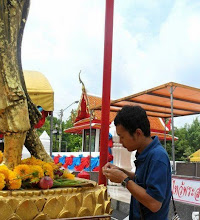

Every visitor to Bangkok should see the magnificent buildings within the Grand Palace compound to get a feeling of the grandeur architectural style.
Since the founding of Bangkok as the Nations capital by King Rama I, The Grand Palace has been the major architectural symbol of The Thai Royal Family. In the present time, The Royal Family resides at Chitralada Palace while The Grand Palace is used for ceremonial purposes.
The main buildings within the Grand Palace compound were built for King Rama V, who was the first Thai King to travel to Europe.
Phra Thinang Chakri Maha Prasat, built in 1877 by King Rama V as his Royal Residence, is the most highly recognized architectural landmark of the Nation. The central Throne Hall, which was formerly used for the reception of foreign envoys, is flanked by reception areas decorated with galleries of portraiture. The central room on the second floor is used as a shrine for the reliquary ashes of Kings Rama IV, Rama V, Rama VI, Rama VII and Rama VIII.
Borom Phiman Mansion was also constructed during the reign of King Rama V. When his son, King Rama VI ascended to the throne, he had it improved for use as his residence. The three succeeding Kings also resided here at one time or another.
The Siwalai Gardens, where the office of The Royal Household Bureau is located, were used for receptions as well as a recreation area for the royal women and children.
Maha Monthien Prasat houses The Audience Hall of Amarin Winitchai where ceremonies of the Court usually take place in front of the throne surmounted by its canopy of nine tiers of white cloth.
How to go there:The most enjoyable route is to take the BTS Skytrain to Taksin Station. From here take a Chao Phraya River Express boat to Tha Chang Wang Luang Pier. It is a short walk from the pier to the entrance to The Grand Palace public entrance.
Opening Hours: Open to the public everyday, except during special Royal Ceremonies, from 8.30 a.m. to 3.30 p.m.
During January 2-10, 2008 foreign visitors will be allowed to visit only Wat Phra Kaew area and enter on the main gate (Sawatdisopha Gate) which is on Sanamchai Road opposite Ministry of Defence.
Admission Fee: Baht 250. This also includes admission to Wat Phra Kaeo, The Royal Thai Decorations & Coins Pavilion in the same compound and to Vimanmek Mansion Museum on Ratchawithi Road. Baht 100. for rental personal audio guide in English, French, German, Spanish, Russian, Japanese or Mandarin.
Dress Code: Visitors are required to dress appropriately. Thus the following dress - code (applicable to both ladies and gentlemen) is requested:
1. Shorts, mini-skirts, short skirts, tight fitting trousers, as well as tights can not be worn as outer garments.
2. See-through shirts and blouses, as well as culottes or quarter length trousers can not be worn.
3. Sleeveless shirts or vests can not be worn as outer garments.
4. Sandals (without ankle or heel straps) can not be worn.
5. All shirt sleeves, whether long or short, can not be rolled up.
6. Sweat shirts and sweat pants, wind-cheaters, pajamas and fisherman trousers can not be worn.




























































